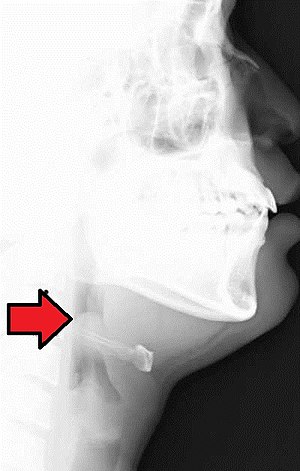Epiglottitis
| Epiglottitis | |
|---|---|
| Synonyms | acute supraglottitis |
 |
|
| Neck X-ray showing thumbprint sign. | |
| Classification and external resources | |
| Specialty | pulmonology |
| ICD-10 | J05.1 |
| ICD-9-CM | 464.3, 476.1 |
| DiseasesDB | 4360 |
| MedlinePlus | 000605 |
| eMedicine | emerg/169 emerg/375 ped/700 |
| Patient UK | Epiglottitis |
| MeSH | D004826 |
Epiglottitis is inflammation of the epiglottis—the flap at the base of the tongue that keeps food from going into the trachea (windpipe). Symptoms are usually rapid in onset and include trouble swallowing which can result in drooling, changes to the voice, fever, and an increased breathing rate. As the epiglottis is in the upper airway, swelling can interfere with breathing. People may lean forward in an effort to open the airway. As the condition worsens stridor and bluish skin may occur.
Epiglottitis was historically mostly caused by infection by H. influenzae type b. With vaccination it is now more often caused by other bacteria. Other possible causes include burns and trauma to the area. The most accurate way to make the diagnosis is to look directly at the epiglottis. X-rays of the neck from the side may show a "thumbprint sign" but the lack of this sign does not mean the condition is absent.
An effective vaccine, the Hib vaccine, has been available since the 1980s. The antibiotic rifampin may also be used to prevent the disease among those who have been exposed to the disease and are at high risk. The most important part of treatment involves securing the airway, which is often done by endotracheal intubation. Intravenous antibiotics such as ceftriaxone and possibly vancomycin or clindamycin is then given.Corticosteroids are also typically used. With appropriate treatment, the risk of death among children with the condition is about one percent and among adults is seven percent.
...
Wikipedia
